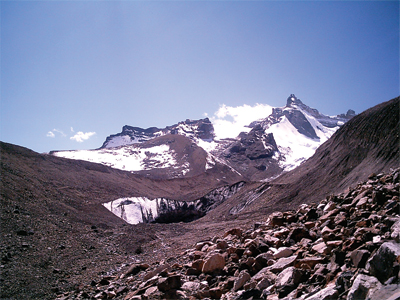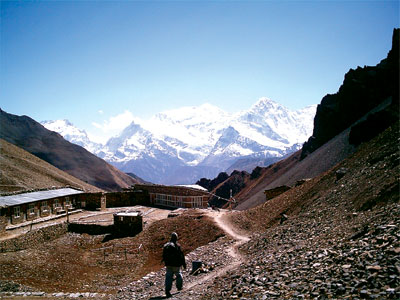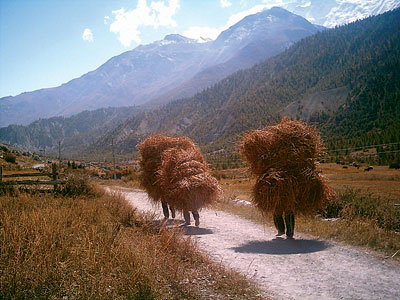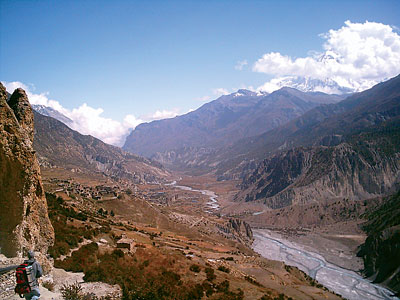Equipped with Parmesan Cheese and salame, an Italian ventures out to soak in the mud, sweat and isolation of Manang.
Being the first Enfielder to reach Chame VDC had been my dream ever since I heard that the road in remote areas of Manang was about to be completed. Fully equipped, trained in motorbike repairing skills and with the blessings of my mechanic, I hit the road.
I started my journey to Manang with Charlene, my reliable Royal Enfield motorbike, a few t-shirts, a pair of jeans, a stock of Italian Parmesan cheese, all kinds of salami and prosciutto and a quantity of rum enough for a pirates’ party. I left home on the Saturday before Dashain and in a few minutes found myself stuck in an incredible traffic jam. The queue of vehicles started at Kalanki and went on all the way down to Naubise. Quite behind schedule, I decided to have my first stop at Besisahar, the gate to Manang and the Annapurna round trek. After checking at a local hotel, inebriated by the excitement of the trip and by the second bottle of warm beer, I incorrectly calculated that my trip was almost completed. Travelling with a motorbike is indeed faster than any other means of transportation, and according to my guide I was only 60 km to Chame, my final destination on two wheels. I needed to slow down, and enjoy the ride. But I didn’t know what I was facing ahead.
 The morning after, the sun was shining, my bike roared on my first kick and I was ready to go. A few kilometers later, when the road changed a rough stony path, I found the first of many water crossings that would make my journey less comfortable and very wet. Having misjudged the depth of a muddy pond, I thought I would just not think about it and gunned it frantically. When the water reached my knees and filled my tool bag, my sleeping bag and almost inundated my precious stock of Italian goods, I realized I was in trouble. One more inch deeper and the carburetor would have been under water, my bike would have stalled and I would have had to spend the afternoon like a water buffalo, waiting to be rescued. With the last hit of gas, I got out of trouble and continued on my adventure half covered in mud.
The morning after, the sun was shining, my bike roared on my first kick and I was ready to go. A few kilometers later, when the road changed a rough stony path, I found the first of many water crossings that would make my journey less comfortable and very wet. Having misjudged the depth of a muddy pond, I thought I would just not think about it and gunned it frantically. When the water reached my knees and filled my tool bag, my sleeping bag and almost inundated my precious stock of Italian goods, I realized I was in trouble. One more inch deeper and the carburetor would have been under water, my bike would have stalled and I would have had to spend the afternoon like a water buffalo, waiting to be rescued. With the last hit of gas, I got out of trouble and continued on my adventure half covered in mud.
Still smiling and full of enthusiasm, I reached Jagat. Served by the newly built road, the region’s economy has been affected by jeep services from Besisahar to Chame and vice versa, with many trekkers preferring to skip the 3-4 day walk it is otherwise. Jagat, like many small villages that benefitted from trekkers’ expenditures is now an even more transitory place, where jeeps packed with tourists and locals don’t stop. I was however forced to stop by a smiling man who barred my way to divert me into his small restaurant and have lunch there. Dal bhaat - what else? The aspect of the meal was familiar and reassuring, but its price was not. Yes, I was told that the higher you go the higher the prices, but I wasn’t ready to pay 100 rupees for a bottle of water and 350 for a vegetarian meal! Being able to stutter some Nepali words, I engaged in a conversation with the man and I began to realize the frailty of the local economy and the changes in people’s livelihoods that the road might eventually bring.
 By the time I reached Chyamche it was late afternoon. The ascent wasn’t easy at all and Charlene, my motorbike needed some rest too. I checked in at the “Tibet Lhasa Hotel and Restaurant” on the way and began to appreciate the primary joy of traveling: meeting people. It didn’t take much time to share some thoughts and local whiskey with three friendly Russians from Kamčatka, one of the remotest regions in the world (as they say). Volcano lovers, the trio was heading to the challenging Thorung La pass, something that I didn’t even dare think about. Our friendship was sealed not only by the vast amount of whiskey we drank but also by sharing their delicious chowmein and my prestigious Parmesan cheese that miraculously escaped the early mud flooding.
By the time I reached Chyamche it was late afternoon. The ascent wasn’t easy at all and Charlene, my motorbike needed some rest too. I checked in at the “Tibet Lhasa Hotel and Restaurant” on the way and began to appreciate the primary joy of traveling: meeting people. It didn’t take much time to share some thoughts and local whiskey with three friendly Russians from Kamčatka, one of the remotest regions in the world (as they say). Volcano lovers, the trio was heading to the challenging Thorung La pass, something that I didn’t even dare think about. Our friendship was sealed not only by the vast amount of whiskey we drank but also by sharing their delicious chowmein and my prestigious Parmesan cheese that miraculously escaped the early mud flooding.
It was only the third day of my adventure and I was already covered in dust, rather smelly and fairly exhausted from the harshness of the road. I decided then to listen to local people’s advice and leave the motorbike in Dharapani and continue by foot.
Dharapani – Timang is a short and easy trek, for those who are fit. After five minutes I was over ventilating and soaking wet, my bag-pack was far too heavy and I missed my motorbike’s roaring engine sound already. But the breathtaking panorama of the Himalayas did inspire me and I was able to crawl to the next lodge. Right in front of my lodge, there they were, the Russian trio having a sumptuous dinner. Spring rolls, dhal bhat, momo all smoothly washed down with copious amount of whiskey. What an occasion to bond even more: my stash of Italian cheese and precious salami was well appreciated.
 The next morning I was on the road again, it was pitch dark and cold, but what a beautiful sensation! With the new friends I had met the night before the trek was easy. We chatted away the fatigue until Chame, Manang’s district headquarters. We had lunch sitting under a warm and dazzling sun with Tibetan bread and “soppressa”, a sort of soft salame made with lightly seasoned minced pork that I brought from Italy for the occasion. The freshly deep fried piping hot Tibetan bread was the perfect match for my thinly sliced soppressa. The heat softened the meat even more and the rich fat melted nicely.
The next morning I was on the road again, it was pitch dark and cold, but what a beautiful sensation! With the new friends I had met the night before the trek was easy. We chatted away the fatigue until Chame, Manang’s district headquarters. We had lunch sitting under a warm and dazzling sun with Tibetan bread and “soppressa”, a sort of soft salame made with lightly seasoned minced pork that I brought from Italy for the occasion. The freshly deep fried piping hot Tibetan bread was the perfect match for my thinly sliced soppressa. The heat softened the meat even more and the rich fat melted nicely.
Next stop - Dhikur Pokhari, a sort of highway service station in the middle of nowhere, where trekkers are filled with incredibly expensive dahl bhat rather than petrol. Prices are set by the local committee, so there isn’t much to bargain about. One condition though, if you stay overnight and need to rest, the showers must be hot. After one long day of trekking, a very hot shower is more than appreciated to soothe the muscles and relax the whole body. Chame – Dhilkur Pokhari is not exactly what I would call an extreme trek, but for someone with no training at all and a bag packed with cheese and salami, it was quite extraordinary! The shower turned out to be a mere trickle of lukewarm water which did nothing but freeze my flesh even more.
 I faced a serious decision the morning after: take the lower and faster route to Manang, through Humde, or climb the old panoramic hike with my new friends. I chose the second option, to admire the greatness of Annapurna II and Annapurna IV from the upper route - 7 hours of excruciating ascent, mitigated by the appearance of a bakery. A bakery? At 3600m above sea level? We were hungry and freezing and we all needed a break. I ordered delicious freshly-baked warm cinnamon rolls each priced a small fortune - but what a pleasant combination it was - enjoying my sweet cake with salty and garlicky salame.
I faced a serious decision the morning after: take the lower and faster route to Manang, through Humde, or climb the old panoramic hike with my new friends. I chose the second option, to admire the greatness of Annapurna II and Annapurna IV from the upper route - 7 hours of excruciating ascent, mitigated by the appearance of a bakery. A bakery? At 3600m above sea level? We were hungry and freezing and we all needed a break. I ordered delicious freshly-baked warm cinnamon rolls each priced a small fortune - but what a pleasant combination it was - enjoying my sweet cake with salty and garlicky salame.
My knees begged me to stop at Ngwall; snow was falling and it was getting dark. There are many places to stay in Ngwall, but the lodge we found not only had an already lit fireplace in the middle of the dining room, but also extraordinarily fast service and really good food. Trekking in the Himalaya region offers many opportunities to enjoy the simplicity of life and appreciate those little things that life in the chaotic lowlands often precludes - warming your hand and feet by the fire, sipping tea, chatting softly about your progress and restoring one’s own energy with simple but tasty food. Outside an icy snow pricked the windows and the wind gained strength. Then I witnessed what happiness really is. A man in his 50s, definitely fit but surely tired from the hike brought a bottle of beer to his table, quickly opened it and eagerly poured the amber liquid into his glass. In two happy gulps the glass was empty. He smiled; to himself, to his fatigue, to the beer itself and he said, “I dreamt about you all day!”
After badly losing hand after hand at backgammon with a charming Frenchman, I sneaked into the kitchen to chat and get some information from locals and some tired porters. I wanted to know about the road, whether it had brought changes in their livelihood, if it had ameliorated the standards of living or if it had just disrupted the normal course of trading and social structure. I was given a bowl of garlic to peel and while helping the cooks I realized that many of the guides and porters were coming from far away, from the Solu-Khumbu region, from the southern Terai belt and the capital. Where were the Manangi people? Such sensitive issues needed more investigation, but the busy nature of the kitchen allowed me no such time. One wood fire stove, two cooks and many people to feed. I saw my potato curry soup being prepared, which thanks to generous amounts of freshly peeled garlic, was indeed a delicacy!
Manang, the end of the journey was only a few hours away. My friends would continue to the 5600m high Thorung La pass and then down to Jomson and eventually to the warm and friendly Pokhara Valley. My clothes were more appropriate for a holiday in the tropical forest than for climbing the frosty Himalayan pass; good excuse. Manang is not exactly New York’s 5th Avenue but its shops offer any and all kinds of trekking equipment, apparel and good food to prepare tourists for the final ascent to the pass. Like many other trekkers who acclimatize before the ascent, I stayed two days in Manang, but only to finish my stash of Parmesan cheese and relax as I admired the gorgeous Gangapurna mountains and its glaciers.
Time to head back. My only and immediate goal was comfort, a hot shower and a plate of rich Spaghetti alla Bolognese. And maybe a glass of white wine… The journey was still long though. I marched downhill and although I had walked the same route on the way up, the view still took my breath away.
I managed to roll down to Bargchhap, a cluster of homes, two guest houses and a Buddhist monastery. The owner of the guest house, on the watch for potential late guests confirmed the great loss of customers staying overnight at his hotel. Lazy trekkers preferred to skip certain areas and used jeeps much to the distress of local businesses. I ordered dal bhat for dinner and opted a bottle of beer to kill time. Being unable to soothe my thirst I ordered a second and then a third bottle while chatting with a young guide from Solu-Khumbu. My perception of reality began to change especially when - at least that is how it appeared to me - the whole village stood behind me fixated on an Indian soap opera where the lead character was the most exquisite example of Italian clichés and stereotypical gestures. The gathered laughed heartily when I talked about Italian men wearing thick gold chains and that beneath a wide collar white shirt every Italian has dense black hair. In no time the whole of Bargchhap seemed to be chanting “mamma mia!” I was on the road again the morning after, riding my Bullet southwards with only one thing in mind: Spaghetti alla Bolognese. I reached Pokhara at sunset and the Himalaya range seemed as if painted in the most beautiful picture ever created.
Nepal is one of the most extraordinary countries I’ve ever lived in. I live in Kathmandu, a city that changes face every day yet maintains its deep roots in an antique and tangible mythological past. Such intricacies of tradition and modernity makes the capital city an example of what wild development is and how radical changes, in a society that is sensitive to traditions and values, are dealt with. But Nepal is not only Kathmandu, it is also the great flat lands of the Terai, with tropical climate and amazing wild life, and the Himalaya, the mountains, the roof of the world. Their greatness, their spectacular colours and shapes and their unreachable majesty make the Himalayas a magical, dangerous, inspiring and powerful environment. People have lived there for millennia and adapted their survival strategies to the rhythms of the mountains, their asperity or generosity throughout the seasons, in an equilibrated system of life. We city dwellers should learn from those who live and respect their land, despite its harshness and isolation. The path I rode on a motorbike and then walked respectfully, is the result of a long term developing plan and in the long term it will provide benefits for a great number of people along its length. Adaptability is the key for success for human beings, and the people of Manang have proved to be masters at that.











